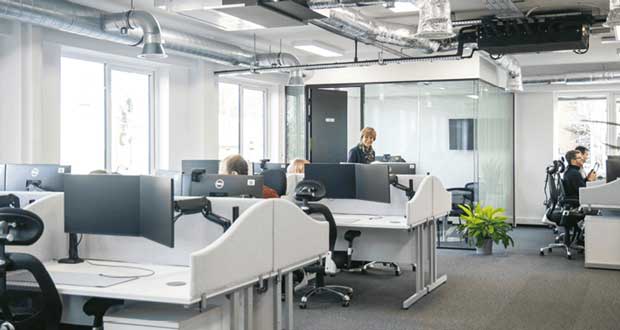 In this Q&A, Tom Garrigan, Technical Director at BSRIA offers his thoughts on taking a holistic approach to IEQ in the drive to net zero
In this Q&A, Tom Garrigan, Technical Director at BSRIA offers his thoughts on taking a holistic approach to IEQ in the drive to net zero
In the UK, people spend roughly 90 per cent of their time indoors. This makes indoor environmental quality (IEQ) a critical factor in the health, comfort, and productivity of the population.
Over the course of the 20th century, buildings’ IEQ improved significantly, driven in part by the availability of cheap energy, the changing attitudes of people in our buildings and the widespread use of mechanical systems designed to enhance comfort. However, many of these systems are not commissioned or operated to optimise energy efficiency, leading to wasteful energy use.
Today, the drive toward Net Zero emissions present an opportunity to rethink how we approach IEQ. The challenge we face now is how to maintain or even improve indoor comfort while drastically reducing carbon emissions. Trickier still is how to change the way buildings are designed and constructed to meet both occupant needs and stricter guidelines.
To understand how this can be done, we first need to drill down into the critical components that make up optimal IEQ. This Q&A asks some of the key questions.
ENERGY DRIVE
Q: Net zero has been a long-discussed topic, has there been enough urgency with the drive to 2050?
A: Achieving net zero by 2050 has been an overarching target, but there’s still work to be done to create the urgency needed to meet it. We are starting to see more cohesive action across the construction industry, with various sectors developing innovations in energy-efficient materials and design techniques. However, the challenge remains in accelerating these efforts while prioritising comfort and environmental responsibility. It’s not just about reducing emissions but transforming our approach to building design and operation to improve indoor environments without sacrificing environmental health.
CORE PRINCIPLES
Q: Can you share an overview of the core principles to indoor environmental quality?
A: The core principles of IEQ are closely tied to comfort, health, and productivity. Key components include:
- Thermal Comfort: Achieving stable temperatures through efficient insulation, materials, and design that minimise energy reliance.
- Air Quality: Ensuring proper ventilation and reducing indoor pollutants with low-VOC materials, filtration, and outdoor air exchange.
- Natural Light: Maximising daylight access to enhance comfort and reduce artificial lighting needs.
- Acoustics: Managing sound levels and speech intelligibility to create a comfortable and productive indoor environment.
Together, these factors create an indoor environment that benefits occupant wellbeing. But to achieve these benefits sustainably, IEQ principles need to align with energy efficiency goals, often incorporating bioclimatic design to harness natural resources instead of mechanical interventions.
ACHIEVING NET ZERO
Q: IEQ is crucial to the built environment, but how do the various components impact net zero?
A: Ultimately, optimally managing IEQ while pursuing net zero targets relies on making buildings adaptable to the local climate and carefully choosing materials to support both human health and energy efficiency.
RETROFITTING
Q: Instead of stripping our buildings and building from scratch, can a wide-ranging retrofit programme ensure we hit decarbonisation targets?
A: Absolutely, retrofitting existing buildings is one of the most efficient ways to advance toward decarbonisation targets. It’s far more sustainable than demolishing and rebuilding structures. Retrofitting allows for the integration of energy-efficient systems, better insulation, and improved ventilation. This approach not only preserves the embedded carbon within the existing structure but also extends the building’s life in a way that can enhance IEQ. When planned carefully, retrofitting has the potential to meet today’s energy and environmental standards without the carbon footprint of new construction, making it a central strategy in meeting net zero goals.
NEW YEAR, NEW LOOK FOR BSRIA
BSRIA reveals the completion of Phase 1 of a newly retrofitted state-of-the-art offices at BSRIA House in Bracknell. This milestone demonstrates what is possible with existing building stock, showcasing how retrofitting can drive sustainability and create spaces that reflect both innovation and environmental responsibility.
Now fully decoupled from natural gas for space heating and hot water, the installation of a high efficiency low global warming potential (GWP) HVAC system will enhance indoor environmental quality and reduce energy consumption. Scope 1 and 2 greenhouse gas emissions in 2025 are forecast to be 28 per cent lower when compared with the 2022 baseline.
The BSRIA building performance experts meticulously measured the “as-built” performance of the building prior to the commencement of works, enabling informed data-driven decisions to maximise the effectiveness of retrofit measures and financial investment. As part of the ‘Living Laboratory’ project, BSRIA is monitoring in-use performance metrics to evaluate systems and user behaviour, which will further drive continuous whole-building performance optimisation.
The outputs of the office retrofit, and the Living Laboratory will shortly serve as a live case study on the BSRIA website.





